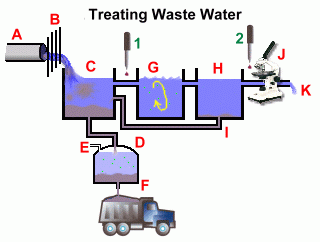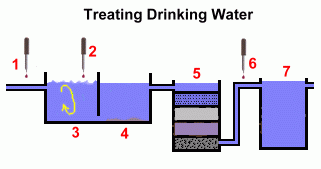
 |
Learn Through English |
 |
Natural Science |
Waste Water Treatment |
A. What are the usual contaminants we can find in waste water?
B. Identify the different parts in the following picture as in the example.
 |
1st Settling tank
|
|
|---|---|---|
Solid collector
|
||
Gas collector
|
||
Town sewers
|
A |
|
Fertilizer collector
|
||
2nd Settling tank
|
||
Screen
|
||
Bacteria addition
|
||
Water tester
|
||
Aeration tank
|
||
Clean water exit
|
C. Once the different parts have been identified, complete the whole process of waste water treatment by playing this game.
D. Where do most cities and towns get their drinking water from? What do we do with that water before we can drink it?
E. These three substances are added to water. What do they do?
| Substance | Function |
|---|---|
CHLORINE |
|
ALUM |
|
LIME |
F. What four materials are used as filters?
| 1 | 2 | 3 | 4 |
G. When waste water has been treated, it goes through a new process to make it drinkable. With the picture help try to reconstruct this process of treating drinking water. Use the clues below. If you still can't manage, try this game.
DIAGRAM |
PROCESS |
CLUES |
 |
1. | More chlorine is added to kill remaining algae and micro-organisms. |
| 2. | The water is stirred in a large tank to make the suspended solids clump together, making them easier to remove. |
|
| 3. | Before it is sent to our homes water is stored in a tank. |
|
| 4. | Chlorine is added to kill micro-organisms. |
|
| 5. | The water flows through the filters |
|
| 6. | Lime and alum may be added, too. |
|
| 7. | The solid clumps are collected from the bottom of a settling tank. |
H. Alternative methods are becoming more and more popular nowadays. Name two advantages.
I. When water is not treated correctly some problems may arise. What happened in North Battleford in Canada? What were the consequences? Who was responsible for that?
Activity adapted from Worsley School website.